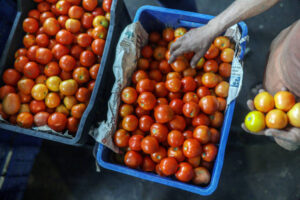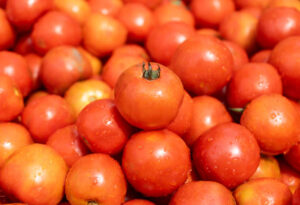What is the size of India’s tomato cultivation? What has fuelled the current tomato inflation? Why is it being described as a seasonal issue? How does a spike in tomato prices

Affact the Consumer Price Index? What are the ways to control the inflation volatility of tomatoes? Why are tomato prices still high?
The Reserve Bank of India’s most recent monthly bulletin noted that the volatility of tomato prices has historically contributed to overall inflation levels in the country. Prices of tomatoes fluctuate between 100 and 200 rupees in different sections of the country.
India produces tomatoes in what ways? According to statistics from the Ministry of Agriculture and Farmers Welfare, the States of Andhra Pradesh, Madhya Pradesh, Karnataka, Odisha, and Gujarat account for close to 50% of the nation’s total tomato production. Every year, there are two significant tomato crops: kharif and rabi. Every year, the rabi crop is available for sale from March through August, while the kharif crop is available starting in September. During the monsoon season, some areas in Maharashtra and Himachal Pradesh’s Solan are capable of producing tomatoes, but in the summer, Andhra Pradesh’s Madanapalle region alone produces all of the nation’s tomatoes. The output of tomatoes reached a peak in 2019–20 at 21.187 million tonnes (MT), and has subsequently been on the decline. It decreased to 20.69MT in 2021–2022 and 20.62MT in 2022–2023.
What causes the price to rise?

Extreme weather conditions and low commercial realisation of the crop for farmers in the months preceding June as well as last year are the two main causes for the decline in overall tomato production this year. Pest assaults on tomato crops were caused by the heatwaves and high temperatures in April and May as well as the delayed monsoon rains in southern India and Maharashtra. As a result, lower-quality cultivars entered the market earlier this year and sold for as little as $6 to $11 per kg to farmers between December 2018 and April 2023.
Many farmers resorted to selling their crops for these sums, while others gave up on their fields. There was a shortage as a result. Later, the new crop was further harmed by the persistent rains in tomato-growing regions. The issue was made worse by the fact that tomato production is at a low point in July and August since it occurs between yields. According to reports, many farmers in the Karnataka district of Kolar, which typically produces a sizable supply of tomatoes, switched to growing beans because of the higher prices it brought in the previous year.
and transient problem. Tomatoes are seasonal, according to Consumer Affairs Ministry Secretary Rohit Kumar Singh, who also noted that data on tomato pricing over the previous five years revealed that prices have increased annually. However, over the years, policy experts have raised concerns about this significant seasonal price fluctuation of tomatoes and its effects on the overall Consumer Price Index (CPI), including the RBI and the National Bank for Agriculture and Rural Development (NABARD). According to a NABARD study from last month, of the three TOP (tomato, onion, potato) agricultural commodities, tomato is the most variable. Vegetables make up a relatively tiny portion of the combined CPI’s food and beverage component, which has a weight of 45.86.
Is it a seasonal issue?
The Center has referred to this abrupt and significant increase in tomato prices as a “seasonal” and transient problem. Tomatoes are seasonal, according to Consumer Affairs Ministry Secretary Rohit Kumar Singh, who also noted that data on tomato pricing from the previous five years revealed that the costs have grown each year at this time.
However, over the years, policy experts have raised concerns about this significant seasonal price fluctuation of tomatoes and its effects on the overall Consumer Price Index (CPI), including the RBI and the National Bank for Agriculture and Rural Development (NABARD). According to a NABARD study from last month, of the three TOP (tomato, onion, potato) agricultural commodities, tomato is the most variable. While the combined CPI gives the food and beverage component a weight of 45.86, vegetables only make up 6.04 of that, and the TOP commodities make up even less, 2.20, of the total.
The TOP’s contribution to the total CPI has been highly erratic, despite its low weight. Tomatoes made up the greatest portion of the 299 items in the CPI basket in June 2022, contributing 8.9% of the total. This is due to a variety of factors, beginning with the fact that it is more perishable than onion and potato. Compounding the issue are problems with the supply chain involved in moving the crop from the locations where it is cultivated to the ones where it is not. According to a July 2022 study by ICRIER, the price of tomatoes has been cyclically fluctuating, with the same issue appearing every other year. Prices for farmers also fell to as low as $2 per kilogram in 2021. Due of this, several of them began growing tomatoes on smaller fields. How can one manage volatility? High volatility, according to policy experts, can be reduced by adopting a few changes. First, because tomatoes are so perishable, better value and supply networks can aid in solving the issue. An organized value chain is a group of companies working together with a market-focused collaboration to manufacture, process, and market goods and services in an effective and efficient way. According to a study by ICRIER, tomato processing capacity should be increased.
In order to turn at least 10% of tomato production into tomato paste and puree during peak seasons and use them in the lean season when fresh tomato prices skyrocket, more processing facilities and links to tomato value chains may be needed. Additionally suggested is the creation of integrated cold chains.
According to a 2022 study, only 32% of the price customers pay for tomatoes goes to the producers. It has been suggested to do away with middlemen, encourage Farmer Producers Organizations to sell produce directly, and change the regulations of Agricultural Produce Market Committees to lower commission and other expenses.



